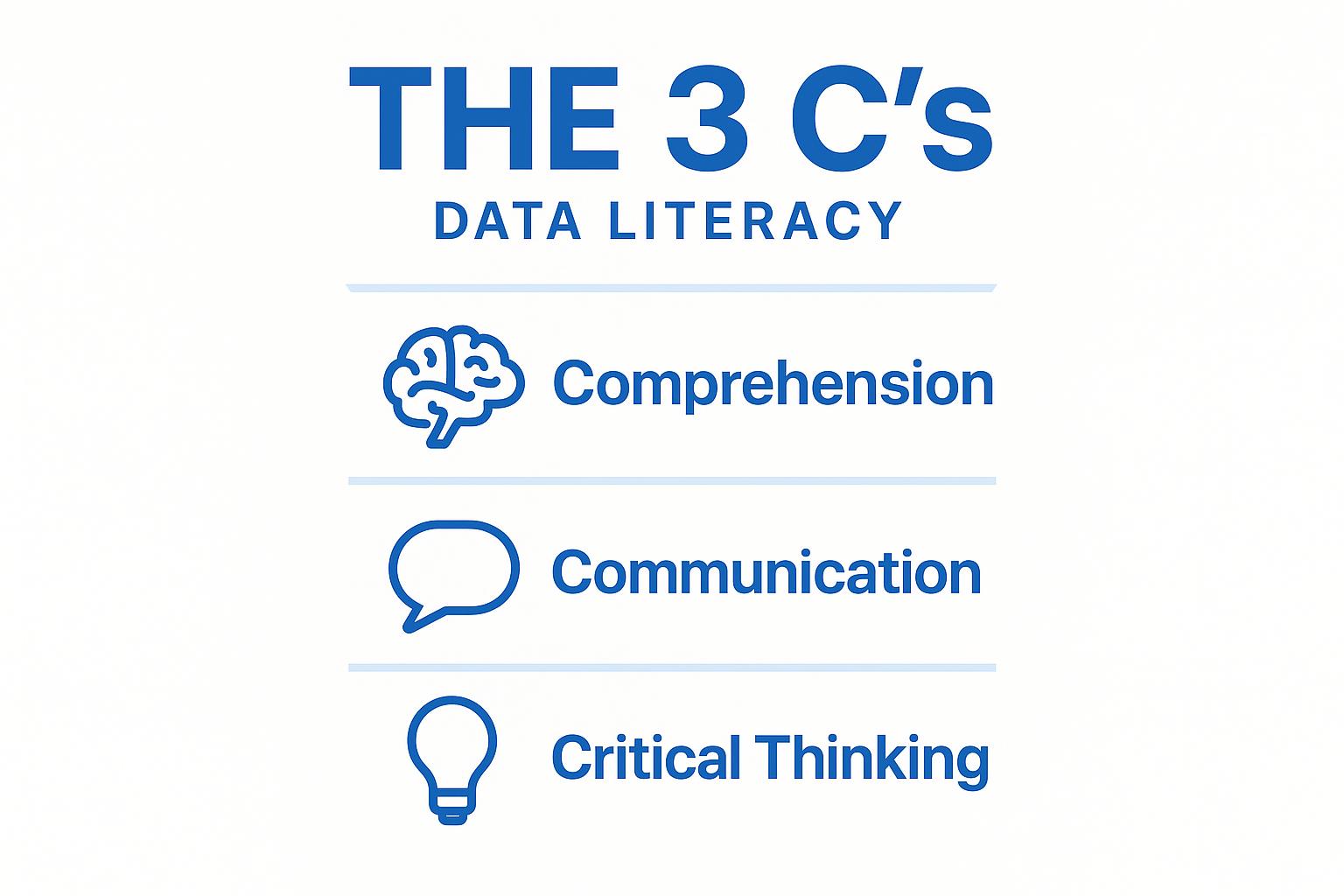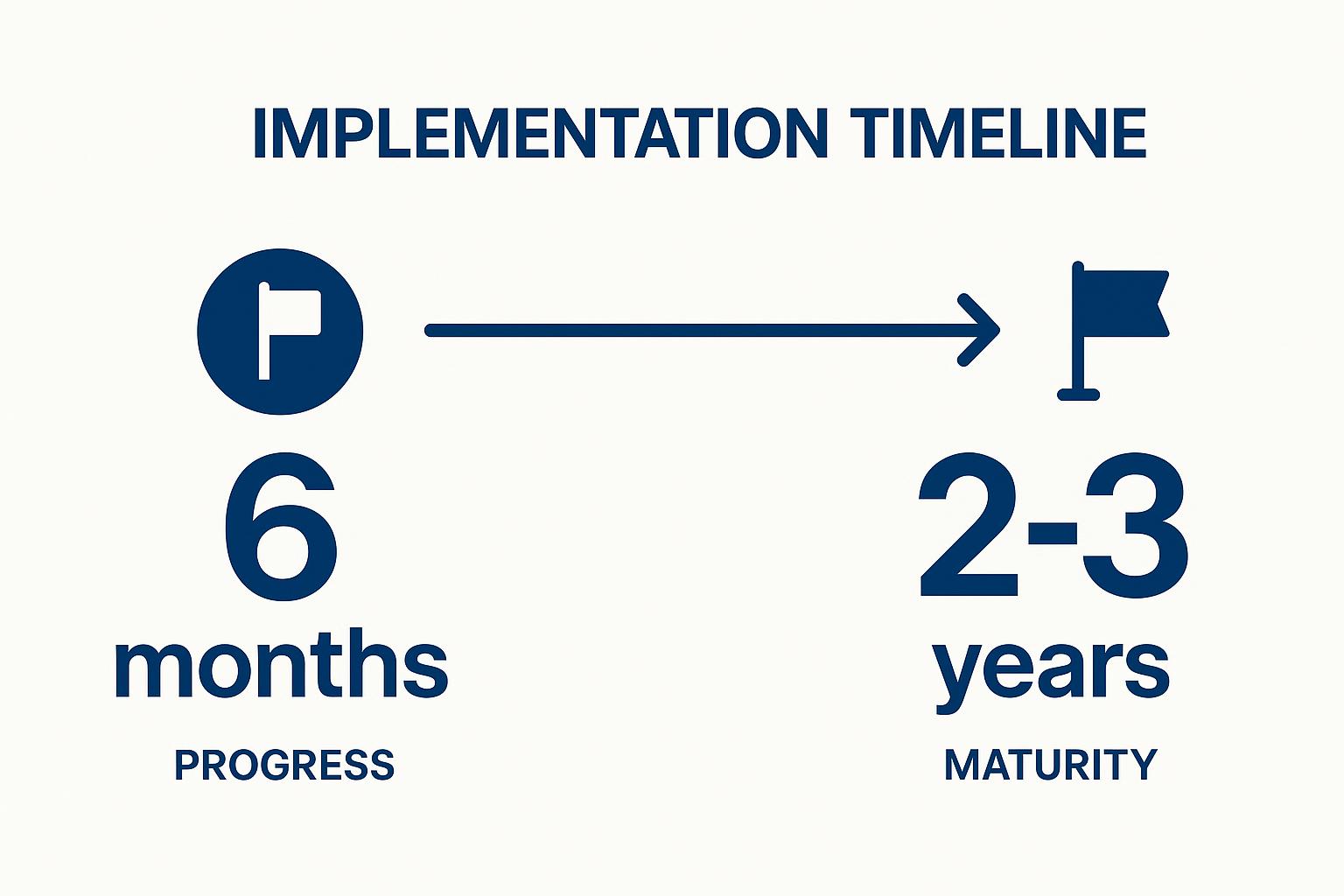What is Data Literacy: Framework, Examples, and Benefits
Summarize this article with:
✨ AI Generated Summary
Data literacy equips organizations with skills to effectively collect, analyze, interpret, and communicate data, driving better business decisions and competitive advantage. Key components include understanding data types, cleaning, statistical reasoning, visualization, and ethical considerations like AI bias and privacy. Implementing structured frameworks, fostering cultural change, and leveraging robust data infrastructure (e.g., Airbyte) enable scalable data literacy development, improving accountability, risk management, operational efficiency, and cross-functional collaboration.
The volume of data being generated continues to grow exponentially, with organizations worldwide recognizing the critical need to understand and utilize this information effectively. Organizations possessing solid corporate data literacy skills show measurable improvements in business outcomes and competitive positioning.
This article provides an in-depth overview of data literacy, its framework, practical applications, and the substantial benefits it offers to businesses in today's data-driven landscape.
What Is Data Literacy and Why Does It Matter?
Data literacy empowers you with the knowledge and skills to work effectively with data across all aspects of your organization. It encompasses understanding data fundamentals such as data types, collection methods, and how data is processed, analyzed, and interpreted to extract meaningful insights that drive business decisions.
Data literacy involves a comprehensive range of capabilities, including assessing the reliability of data sources, identifying trends, patterns, and outliers within datasets, and clearly communicating insights to both technical and non-technical stakeholders. In modern organizations, it extends beyond basic analytical skills to include data governance, ethical considerations, and the integration of emerging technologies like artificial intelligence.
What Is a Data Literacy Framework?
The data literacy framework offers a structured approach to developing the essential skills and competencies needed to work efficiently with data across your organization. It encompasses interconnected capabilities such as data collection, analysis, management, visualization, evaluation, and governance.
Unlike traditional approaches that focus solely on technical skills, modern frameworks integrate business context, ethical considerations, and strategic alignment. By implementing a comprehensive data literacy framework, you gain the knowledge and abilities to navigate data efficiently while developing critical thinking and problem-solving skills.
This structured approach enables organizations to build data capabilities that scale with business growth and adapt to evolving technological landscapes.
What Are the Key Components That Build Strong Data Literacy?
Understanding Data Types, Sources, and Formats
Identify required data, understand its origins, and comprehend its structure. This includes evaluating data quality, assessing source credibility, and understanding how different formats influence analysis.
Different data formats include structured data from databases, unstructured data from documents and social media, real-time streaming data, and IoT sensor data. Each format requires different handling approaches and analytical techniques.
Data Cleaning and Preparation
Detect and correct inconsistencies, errors, or incomplete information. Techniques include handling missing values, removing duplicates, standardizing formats, and maintaining data lineage and quality controls.
Effective data preparation forms the foundation for reliable analysis. Without proper cleaning and preparation, even the most sophisticated analytical techniques will produce questionable results.
Analytical Thinking and Statistical Reasoning
Apply critical thinking, understand basic statistical concepts, recognize correlation vs. causation, and appreciate limitations and biases. This component helps you interpret results accurately and avoid common analytical pitfalls.
Statistical reasoning enables you to distinguish between meaningful patterns and random noise in data. It provides the mathematical foundation for making confident decisions based on data evidence.
Data Visualization and Communication
Select appropriate visualization methods, design clear charts and dashboards, and avoid misleading representations. Effective visualization transforms complex data into accessible insights for decision-makers.
Good visualization requires understanding your audience and choosing the right chart types for different data relationships. Bar charts work well for comparisons, while line charts excel at showing trends over time.
Communication and Storytelling
Craft compelling narratives from data, present findings in business terms, and facilitate data-driven decision-making across the organization. This skill bridges the gap between technical analysis and business action.
Effective data storytelling combines analytical rigor with persuasive communication. It helps stakeholders understand not just what the data shows, but why it matters and what actions they should take.
What Benefits Does Data Literacy Provide to Organizations?
Enhanced Accountability and Performance Tracking
Track progress toward strategic goals, calculate meaningful metrics, and evaluate decisions based on reliable data. Data literacy enables organizations to move beyond gut feelings and intuition toward evidence-based management.
Performance tracking with data literacy means understanding which metrics truly matter and how to interpret them correctly. This prevents the common mistake of optimizing for vanity metrics that don't drive business value.
Advanced Risk Management and Mitigation
Analyze historical patterns, identify risk factors, and develop data-driven mitigation strategies, including data security and privacy compliance. Organizations can anticipate problems before they occur and prepare appropriate responses.
Risk management benefits from data literacy through predictive analytics and trend analysis. Teams can identify early warning indicators and take preventive action rather than simply reacting to problems.
Operational Efficiency and Process Optimization
Identify bottlenecks, streamline workflows, and optimize resources based on evidence rather than assumptions. Data literacy helps organizations understand where inefficiencies exist and how to address them systematically.
Process optimization requires analyzing workflow data to understand where delays occur and which steps add the most value. This evidence-based approach leads to more effective improvement initiatives.
Improved Cross-Functional Communication and Collaboration
Bridge gaps between technical and non-technical teams, facilitating clear communication of insights and evidence-based discussions. Data literacy creates a common language that enables better collaboration across departments.
When team members share data literacy skills, they can engage in more productive discussions about business problems and solutions. This reduces miscommunication and aligns efforts toward common goals.
What Are the Three C's of Data Literacy?

1. Comprehension
Understand and interpret various data sources, read visualizations, and draw meaningful conclusions with business implications. Comprehension forms the foundation that enables all other data literacy skills.
Strong comprehension means you can look at a dataset or visualization and quickly grasp what it represents, identify key patterns, and understand the business context. This skill develops through practice with diverse data sources and formats.
2. Communication
Convey insights clearly to diverse audiences through well-designed visuals, storytelling, and professional reporting. Communication transforms individual understanding into organizational knowledge and action.
Effective communication requires adapting your message to different audiences. Technical teams need detailed methodologies, while executives prefer high-level insights and recommendations for action.
3. Critical Thinking
Question assumptions, evaluate data quality, perform hypothesis testing, and address ethical considerations, including privacy, security, and fairness. Critical thinking prevents costly mistakes and ensures responsible data use.
Critical thinking in data contexts means maintaining healthy skepticism about results, understanding limitations, and considering alternative explanations. This skill becomes increasingly important as data volumes and complexity grow.
Why Are Ethical Considerations Essential in Modern Data Literacy?
Understanding AI Bias and Algorithmic Fairness
Recognize how biases infiltrate models, validate outputs, and implement fairness measures. As organizations increasingly rely on AI and machine learning, understanding these systems becomes crucial for responsible data use.
AI bias can perpetuate or amplify existing societal biases, leading to unfair outcomes for certain groups. Data-literate professionals must understand how to detect and mitigate these biases in their analytical work.
Implementing Responsible AI Practices
Establish governance frameworks, ensure transparency, and maintain accountability for AI outcomes. Responsible AI requires ongoing monitoring and adjustment as systems learn and evolve.
Transparency in AI means being able to explain how systems make decisions and what data influences those decisions. This becomes especially important in regulated industries or high-stakes applications.
Privacy and Compliance in AI-Enhanced Analytics
Navigate GDPR and industry-specific regulations while leveraging generative AI tools. Compliance requires understanding both the technical capabilities and legal requirements for data use.
Privacy protection in AI contexts requires careful attention to data minimization, consent, and purpose limitation. Organizations must balance analytical capabilities with individual privacy rights.
Building AI-Augmented Data Skills
Automate routine tasks with AI, validate AI-generated insights, and combine automated analysis with human expertise. This represents the future direction of data literacy in most organizations.
AI augmentation means using technology to enhance rather than replace human analytical capabilities. This requires understanding when to trust AI outputs and when to apply additional scrutiny or human judgment.
How Do Organizations Assess and Improve Data Literacy Maturity?
1. Assess Maturity Levels
Progress from fragmented data practices to fully institutionalized, data-fluent cultures. Maturity assessment provides a baseline for improvement and helps prioritize development efforts.
Organizations typically evolve through stages from ad-hoc data use to systematic, enterprise-wide data literacy. Understanding your current maturity level helps identify the most impactful next steps.
2. Build Comprehensive Training Programs
Develop tiered tracks, hands-on learning, and continuous assessments. Effective programs recognize that different roles require different levels and types of data literacy skills.
Training programs should combine theoretical knowledge with practical application opportunities. Learners need chances to practice new skills on real organizational data and challenges.
3. Foster Data-Driven Cultural Change
Create communities of practice, mentorship programs, and recognition systems while securing leadership commitment. Cultural change requires sustained effort and visible leadership support.
Data-driven culture means making decisions based on evidence rather than intuition or hierarchy. This cultural shift often represents the most challenging aspect of organizational data literacy development.
4. Measure and Sustain Impact
Track competency baselines, monitor program effectiveness, and tie improvements to business outcomes. Measurement ensures that data literacy investments deliver tangible value to the organization.
Impact measurement should connect data literacy improvements to business metrics like decision speed, accuracy, and outcomes. This connection helps justify continued investment in literacy development.
Scaling Your Data Literacy Framework with Airbyte
Robust data infrastructure underpins effective data literacy. Airbyte consolidates data from 600+ sources or custom connectors via the Connector Development Kit into centralized repositories, ensuring a single source of truth.
Features such as Change Data Capture and flexible deployment options support responsible data practices and scalable literacy initiatives; however, end-to-end encryption and role-based access controls are not confirmed as core built-in features. This infrastructure foundation enables organizations to focus on developing analytical skills rather than managing data integration complexity.
Airbyte's approach eliminates the technical barriers that often prevent organizations from building comprehensive data literacy programs. By providing reliable, accessible data infrastructure, teams can concentrate on developing the analytical and communication skills that drive business value.
Conclusion
Data literacy is fundamental for organizations seeking competitive advantage and operational excellence in today's data-driven business environment. By adopting comprehensive frameworks that blend technical skills, ethical considerations, and cultural change, organizations can transform their decision-making capabilities and operational efficiency. Supporting these initiatives with a robust integration infrastructure enables teams to focus on developing valuable analytical skills rather than managing technical complexity. The investment in organizational data literacy pays dividends through improved decision-making, reduced risks, and enhanced ability to adapt to changing market conditions.
Frequently Asked Questions
What abilities are included in data literacy?
Data literacy encompasses finding, cleaning, analyzing, interpreting, and communicating with data to extract valuable insights. Modern data literacy also includes understanding ethical considerations, recognizing biases, and effectively integrating AI tools into analytical workflows.
How is data literacy evaluated in organizations?
Organizations assess data literacy through competency-based evaluations that measure interpretive skills, analytical tool usage, and decision-making capabilities. This includes scenario-based assessments, practical exercises, and the evaluation of real-world applications of data skills in business contexts.
What role does AI play in modern data literacy?
AI enhances data literacy by automating routine analytical tasks and enabling focus on strategic analysis. However, it also requires new skills in AI tool evaluation, bias recognition, and understanding the limitations of automated systems.
How long does it take to implement organizational data literacy programs?

Implementation timelines vary based on organizational size and complexity, but most comprehensive programs show measurable progress within six months and achieve significant maturity within two to three years of sustained effort.
What are the most common barriers to data literacy adoption?
Common barriers include resistance to cultural change, lack of leadership commitment, insufficient training resources, and inadequate data infrastructure. Successful programs address these challenges through comprehensive change management and sustained investment in capabilities development.

.webp)
.png)